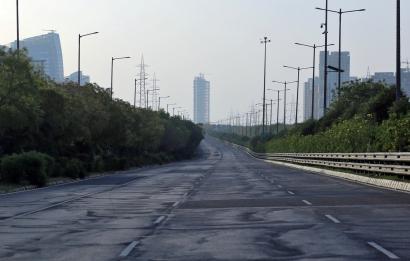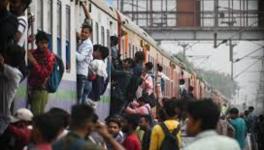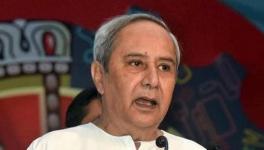What is a Lockdown all About Anyway?

Representational image. | Image Courtesy: Quartz
“South Korea has had 154 deaths. Total so far. No lockdown. UK has already had 2,352 (deaths) with 563 in the last 24 hours. In lockdown for three weeks with major social & economic costs.” This was tweeted on April 1, by Dr Devi Sridhar of Edinburgh University, a leading expert on global public health policy.
Two weeks later, the United Kingdom’s COVID-19 death toll has climbed to a startling figure of 11,329, while the equivalent figure for South Korea is 222. New COVID-19 cases and deaths have been galloping since the UK went under lockdown – 8,681 new cases and 980 deaths were recorded as recently as April 10.
Fortunately, the number of new cases and deaths in the UK has been dropping since then, holding out hope that the country has crossed the peak. Meanwhile, with just 25 new cases and only 3 deaths reported on April 13, South Korea seems to have successfully ‘flattened the curve’.
Notably, South Korea’s record didn’t always look this good. It could not prevent outbreaks from happening in the initial stage; and two infection clusters formed early on in Daegu, a city of 25 lakh people, and the municipality of Cheongdo. However, it still managed to contain the epidemic through an aggressive strategy of testing, tracing of contacts and social distancing.
This achievement is all the more remarkable because it was done without imposing large-scale confinement or travel restrictions. South Korea and its South Asian compatriots, Taiwan and Hong Kong, are among a handful of examples which have bucked the global trend of lockdowns, but still managed to effectively contain the epidemic; the reason they are now being hailed as models by public health experts.
In sharp contrast to them are countries like the UK, which have proven unequal to the task of containing COVID-19, despite having one of the world’s best public healthcare systems. In the UK’s case, the fiasco has been blamed on the government’s badly executed initial strategy of letting the population acquire natural immunity (or ‘herd immunity’ in epidemiological parlance).
So; on the one hand, we have South Korea, one of the best examples of a major country tackling the pandemic effectively, and doing so without a lockdown. On the other, there is the cautionary tale of the UK, which failed dismally to keep it in check in spite of a lockdown. What really is going on here? What lessons does this have for India, which has just extended its national lockdown by another two weeks?
Their lockdowns and our lockdowns
It’s true that neither South Korea nor England is comparable to India – but, that ought to be only more cause for concern, not less. Because, on just about every criterion for an effective response to COVID-19 – demography, governance, technology, finance or public health infrastructure – India is so disadvantaged in comparison to those two countries, as to be almost in a category of its own.
India’s three-week national lockdown, declared on March 24, too is in its own category; it is the largest ever such experiment in history given the territory it covers and the number of lives it has impacted. It is also the harshest in the world, beating even China in its excesses.
A recent estimate calculates that the lockdown has caused a shocking 195 deaths, including deaths due to hunger, exhaustion; and these are just the deaths that have been reported. Not surprisingly, India has scored a perfect 100 for stringency on the Oxford COVID-19 Government Response Tracker; an index that “does not represent the effectiveness of these measures.”
It is worth recalling that China has not imposed a national lockdown till date, having put only individual cities and one province, Hubei, under lockdown. In its response to the Hubei lockdown, human rights watchdog Amnesty International had stated on February 5, “Censorship, discrimination, arbitrary detention and human rights violations have no place in the fight against the coronavirus epidemic.” Such niceties were ignored as the world’s governments scrambled to implement lockdown measures in country after country.
In fact, graver problems than human rights violations – or even the pandemic itself – may await India’s most vulnerable groups, in the coming days and months. The International Labour Organisation has identified informal sector workers in India as one of the groups most impacted by lockdown measures globally, estimating that 400 million of them now risk falling deeper into poverty. This follows in the wake of urgent warnings issued by a chorus of Indian voices, including such stellar names as public health experts Vikram Patel and Jayaprakash Muliyil, economists Jean Dreze, Raghuram Rajan and Jayati Ghosh, and former senior bureaucrats Pronab Sen and Siraj Hussein.
These dire prognoses are being confirmed by a steady stream of reports from the ground, which document the mounting toll of the lockdown on the lives and livelihoods of those most vulnerable. Relief measures announced by the government have proven inadequate in meeting the crisis; reports show that more people are being fed meals by NGOs than government in at least 13 Indian states.
In competent hands?
On March 26, as India entered the second day of its national lockdown, there was an official attempt to calm the citizenry which presented the decision as something of a miracle cure. In a media briefing, the Indian Council of Medical Research or ICMR’s Raman Gangakhedkar asserted, “If the lockdown is successful then we may not even see the current numbers budge.” No evidence was offered to support this claim. Yet, Lav Agarwal of the Health Ministry, also present, chimed in, "While the numbers of COVID-19 cases are increasing, the rate at which they are increasing appears to be relatively stabilising. However, this is only the initial trend."
Their timing couldn’t have been more wrong; because the very next day, India reported 160 new COVID-19 cases, the highest for any single day until that point. India’s tally, which started climbing dramatically from March 26, now stands at 10,541 cases and 358 deaths. On April 13 alone, India reported 1,248 cases, twice the total number of cases recorded until March 26, the day we were told that thanks to the lockdown, the numbers “may not budge”.
Three weeks later, the evidence sharply contradicts the exaggerated claims made for India’s national lockdown. As in the case of the UK and several other countries, it may be much more accurate to describe it as proof of administrative failure. After all, if a government decides to shut the whole country down, it confirms that whatever else it tried has failed; or worse, that it had not even tried enough. In India’s case, the evidence increasingly points to the latter conclusion. (For details, see an earlier analysis by this writer of crucial policy lapses in the initial stage of the pandemic in India)
Hard questions for the ‘new normal’
Undoubtedly, the COVID-19 pandemic is a complex and dynamic phenomenon that has prompted widely varying responses, with equally varied outcomes. Its dramatically different trajectories in South Korea and England demonstrate just how extreme and counter-intuitive these outcomes can be. Given this global context, added to the sledgehammer-like impact it has had for India’s economy and its poorest citizens, several questions remain about India’s national lockdown strategy:
What was the scientific rationale for India’s lockdown? What was the exact basis for its timing – why was it imposed when it was? Why did it have to be national, and imposed all at once (as opposed to being geographically targeted, and implemented in a phased manner)? Why weren’t 1.33 billion citizens of a democratic country given time to prepare for such a decision of such momentous impact? Now that we are locked down, what measures have been taken to make sure that we’re making the best of it?
The lockdown, in some form or the other, looks set to become a new way of life for those who can afford it – even as it becomes a new way of death for those who cannot. Rather than take it for granted, we must see the lockdown for the desperate, costly and even potentially counterproductive method it is. One as much in need of close public scrutiny as any other extreme policy measure in a democracy.
The writer is a freelance journalist. The views are personal.
Get the latest reports & analysis with people's perspective on Protests, movements & deep analytical videos, discussions of the current affairs in your Telegram app. Subscribe to NewsClick's Telegram channel & get Real-Time updates on stories, as they get published on our website.
























